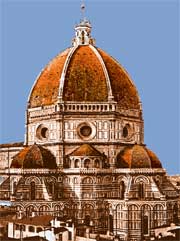Filippo Brunelleschi
Filippo Brunelleschi, one of the great Renaissance architects, was born in Florence in the year 1377. His wealthy family was among the aristocracy of Florence, and possessed many properties, among them a row of houses opposite Orsanmichele. His father was a lawyer and an Ambassador of State.
Brunelleschi's Early Life and Education
Filippo’s father wanted his son to become a man of letters, and placed him in one of the best humanist schools. There, the child studied the Scriptures and the poets. But even then, his greatest pleasure was in the art of design. Showing his architectural aptitudes, very often he would be found drawing houses and geometrical figures.
His father was a wise man, and he realized that the young Brunelleschi will not succeed in his guild of notaries and judges, which required classic and literary training. Thus he allowed the youngster to choose his career.
It should be mentioned that, after finishing the school curriculum, every young man was apprenticed to one of the civic industrial guilds, or arti. A Florentine who was not member of one of the arti had no civil rights.

Filippo Brunelleschi - Duomo
Santa Maria del Fiore, Florence
On December 1398, the young Filippo was sworn as a member of the “Arte della Seta”. His choice was to graduate as a goldsmith. This gave him the chance of full artistic training, as the guild included trades like modelers, workers in metal, and painters.
Filippo could cut and set gems at the same level as the best goldsmiths. In the same time, he studied all the sciences necessary to become a perfect artist. Mathematics and design knowledge led the talented young man to his discoveries in perspective. Indeed, Manetti considers Brunelleschi as the inventor of the science. The first scientific design he made in perspective was that of the Baptistery of Florence. Not only did Brunelleschi invent the rules of perspective, but he discovered an original method of looking at such drawings, by making a funnel-shaped hole in the picture.
He enjoyed his apprenticeship life. He was surrounded by the best artists of the time, and he met all architects and sculptors in Florence. He was a good friend of Masaccio, to whom he imparted his discoveries in perspective.
Despite what Vasari says, Brunelleschi never renounced reading books. There were two he especially cared for: Dante and the Bible. According to Vasari, he had an outstanding memory for quoting the Scriptures, and Toscanelli said that “Filippo talked like St. Paul come to life again.”
As for moral virtues, Filippo Brunelleschi was kind and judged without passion. He was helpful and recognized the merits of others. However, he had his moments of selfishness. He refused to divulge his method of moving the large blocks of marble, which would have been of inestimable use to other architects.
Brunelleschi was the architect of his own house in which he lived and died. It is a perfect example of good, solid 14th century architectural design. Vasari says that Brunelleschi’ genius seemed sent from heaven to bring back the true form of architecture which for centuries had been lost.
Competition for Baptistery doorsFilippo Brunelleschi was among the participants in the well-known competition for the Baptistery doors, taking place in Florence in the first year of the 15th Century. That may be a convenient point from which to trace the germination of Renaissance architecture.
The goldsmiths and sculptors of Tuscany who took part in the competition were Jacopo della Quercia, Niccolo d' Arezzo, Francesco Val d'Ombrino, Simone da Colle, Niccolo Lamberti, Filippo Brunelleschi, and Lorenzo Ghiberti.
The requirements were that each competitor should model a relief, in bronze, of a single panel, representing the offering up of Isaac. A year was allowed for its completion, the lines of Andrea Pisano in an earlier gate (1330 - 36) of the Baptistery being closely followed.
Filippo Brunelleschi's group was in many respects a finer composition, but was of less excellence as a bronze casting, and received the second place. Possibly Brunelleschi would have arrived at a nobler design for the gate had the competition been on a different basis, but in the test panel Ghiberti was adjudged successful, and was ultimately entrusted with the work.
This competition was the turning-point in the life of Brunelleschi, the point at which he abandoned sculpture and dedicated his genius to architecture
The decision in this competition seems to have led Filippo Brunelleschi to try another path in which he might attain the undisputed supremacy his ambitious and somewhat exclusive nature craved. The story has often been told how he set out for Rome about the year 1403 with an admiring friend, Donato di Niccolo di Betti Bardi, afterwards known to fame as Donatello, who was then just sixteen years old, and how, supporting himself as a goldsmith, he gave the most ardent attention for about four years to the architecture of the Roman Empire buildings, with the view of gaining a grasp of the principles of the classical styles.
Filippo Brunelleschi and The Duomo in Florence
Returning to Florence, Brunelleschi occupied his mind with the completion of the cathedral. The construction, begun by Arnolfo del Cambio about one hundred and twelve years before, and continued by Giotto and Francesco Talenti, was still in a slow process of development. A council of architects had met in 1366 and fixed the shape of the choir and dome, but considerable indecision prevailed as to the best manner of covering the great octagonal opening and the three apses. By all the influence he could command, Filippo persuaded the Council to carry out his ideas.
For Brunelleschi, the Council approval opened the path towards his greatest architectural achievement, the Duomo of Santa Maria del Fiore Cathedral.
Filippo Brunelleschi - Master Architect of the Florence Dome